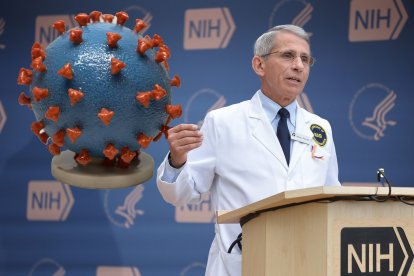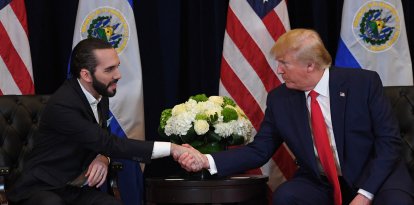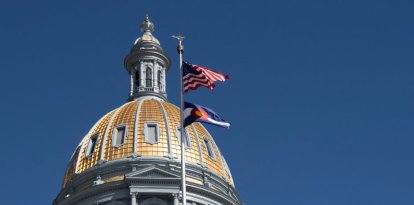Storm at the NIH: Concern about its role in the origin of COVID-19, lack of transparency and threats of reform
Republican lawmakers unveiled a new proposal to break up the institute in charge of the world's largest biomedical research funding agency.

(CordonPress)
The "Hygenic Laboratory," as its founder, physician Joseph J. Kinyoun, called it, was created more than a century ago in a one room laboratory inside a Navy Hospital. Its purpose was to study how certain microscopic organisms caused infectious diseases. Ultimately, its goal was to prevent the importation of epidemics.
More than a century later, that laboratory-room grew to become the public organization that funds the most biomedical research in the world: the National Institutes of Health (NIH).
It currently has a budget of nearly $50 billion and more than 18,000 employees. It is made up of 27 institutes and centers, each with its own mission. There's everything from the National Eye Institute (NEI), dedicated, as its name suggests, to the study of the eye, to the Center for Scientific Review (CSR), dedicated to reviewing which grants get sent to various institutions around the world.
But this empire is facing a crisis of confidence that may have serious consequences. After almost a decade, since its last budget was approved, Congress is preparing to review its performance with a series of proposals. They will have to navigate political polarization and resistance from patient groups, scientists and businesses.
A wounded reputation
The NIH used to have a solid political reputation, enough to have both Democratic and Republican backing. There was no shortage, however, of questions about the size and sluggishness of its bureaucracy. There was even a proposal to reduce its institutes from 27 to six. There was a disproportionate distribution of its grants. The NIH claimed this was due to its size. Critics alleged that this put minorities such as African-Americans and Hispanics at a disadvantage. These grants went to a select few institutions such as UCLA, Duke and Stanford.
A recent report from the House Energy and Commerce Committee revealed that the NIH lied to the committee about "risky" monkey virus research. It also revealed information that scientists at the institutes had tried to hide the fact that they received around $710 million in royalties from private companies.
However, the new demands for reform lies in the mystery of the origin of the 2020 pandemic.
NIH and the genesis of COVID-19
After four years, the origin of the pandemic remains unclear. There are two theories. The natural contagion theory claims that the virus was transmitted directly from an animal, perhaps a bat or pangolin, to a person, and from there from person to person. The other theory is that of the laboratory accident. This theory claims that man created the contagious virus that, by one route or another, managed to get leaked from a research center.
Wuhan, China, the site where cases of contagion were first detected, has scenarios to argue both theories. While some blame the city's wet market as a possible place where someone could have ingested an infected animal, others point to the Wuhan Institute of Virology (WIV).
The NIH comes into play because it would have subsidized the nonprofit EcoHealth Alliance (EHA), which in turn funded bat virus research at the Wuhan lab. Therefore, there could be a link between U.S. taxpayer money, distributed by the NIH, and the onset of the pandemic.

Society
Tennessee: Woman receives nearly $700,000 after her company fired her for refusing to get COVID-19 vaccine
Rosana Rábago Sainz
Gain of function
Gain-of-function (GOF) is a type of research that is under scrutiny. It involves a set of techniques that alter the functions of an organism to increase its capabilities. For example, a virus could be modified to make it more transmissible or harmful.
"Gain-of-function experiments in the lab can help scientists anticipate the changes viruses may undergo in nature by understanding what specific features allow them to transmit between people and infect them," Microbiology and Immunology professors Seema Lakdawala and Anice Lowen said in a paper defending GOF.
"In contrast to nature’s experiments, these are conducted in highly controlled lab conditions designed to limit infection risk to laboratory personnel and others, including air flow control, personal protective equipment and waste sterilization," they explained before warning:
"It is important that researchers carefully observe lab safety to minimize the theoretical risk of infecting the general population. It is equally important that virologists continue to apply the tools of modern science to gauge the risk of natural viral spillovers before they become outbreaks."
Although the government suspended funding to EcoHealth Alliance and established new guidelines this year to oversee gain-of-function studies, in addition to investigations of 'dual-use' pathogens which have the potential to be used as bioweapons, the doubts about the origin of COVID-19 make people wonder whether these initiatives will be enough.
Initially, U.S. health authorities were dismissive of the idea that the virus had been created during a gain-of-function study in Wuhan. They went so far as to label it a conspiracy.
Anthony Fauci, then president of NIAID, was the initial critic. But in June of this year, Fauci, who was once the government's pandemic response spokesman, surprised the world by changing his stance. "I keep an open mind as to what the origin is," he said in his first public testimony before the House of Representatives since leaving office.
Despite assuring that the NIH-funded studies could not be precursors to SARS-CoV-2, he did not rule out that other research conducted at the Chinese center could have started the pandemic.
Fauci's firm stance against the artificial origin hypothesis and subsequent dithering is one of the reasons behind the NIH's crisis of confidence.
Projects for change
"Given concerns raised during and after the Covid-19 pandemic and the need to maximize the impact of taxpayer money, it is imperative to build a stronger and more accountable NIH," said Representatives Cathy McMorris Rodgers and Robert B. Aderholt in an opinion article published in the trade journal Stat.
In that article, Republican lawmakers presented a plan to reform the public agency. It would reduce, among other measures, its institutes and centers from 27 to 15. It would also halt funding of gain-of-function studies on dangerous pathogens until better oversight policies are in place. Approval of the latter would shift to an "public, independent oversight entity."
It would also split the National Institute of Allergy and Infectious Diseases (NIAID) in two, apparently to take power away from the position formerly held by Fauci. It also intends to address other "persistent issues, such as a lack of transparency in certain grant funding mechanisms and rampant sexual harassment, as well as more recently exposed problems like the escalating threat of foreign undue influence."
A proposal released in late June by House Republicans would maintain the previous fiscal year's budget: around $48 billion.
Sen. Bill Cassidy published a series of proposals in May that include measures to reduce structural redundancies, improve transparency and data collection on funded programs, plus address misconduct.
Like Rodgers and Aderholt, Cassidy stressed the need to regain trust in the agency: "Public sentiment toward scientific institutions has degraded in recent years, exacerbated by a perceived lack of transparency and concerns about political biases during the COVID-19 pandemic response. In order for the potential of future NIH research to be fully realized, the agency must make restoring public trust in the scientific process and scientific institutions a priority."
Democratic Rep. Diana DeGette and Republican Larry Bucshon sent letters in June asking for input from interest groups to analyze the impact of and propose updates to a law that funded the NIH in 2016.
A difficult road ahead
Jocelyn Kaiser, a specialty reporter who covers the NIH for Science, told Voz, "The main obstacle to merging institutes is that there will always be patient advocacy or other groups (including scientist groups) opposing most mergers."
Research!America and United for Medical Research, for example, both issued statements rejecting the most recent initiatives to reduce the agency's funding. The latter said, "The decision to cut the allocation that funds the National Institutes of Health (NIH) and other research agencies as our nation confronts such massive health threats as Alzheimer’s, the opioid crisis heightened by the Fentanyl epidemic, and maternal mortality, is chilling."
Kaiser claims that lobbyists, including patient groups, believe that "mergers would lead to less research funding for their disease." However, she clarified that there are many reasons why they oppose it: the alcoholic beverage industry fought an initiative to merge alcohol and drug abuse institutes on the grounds that it would stigmatize consumers.
On the legislators' side, the partisan gap seems less unbridgeable. Legislators from both parties felt that the NIH needed changes. Kaiser said that Democrats might look favorably on Rodgers and Aderholt's plan because it does not completely eliminate gain-of-function research. "There is certainly room for bipartisan consensus on some NIH reform issues."
RECOMMENDATION
























